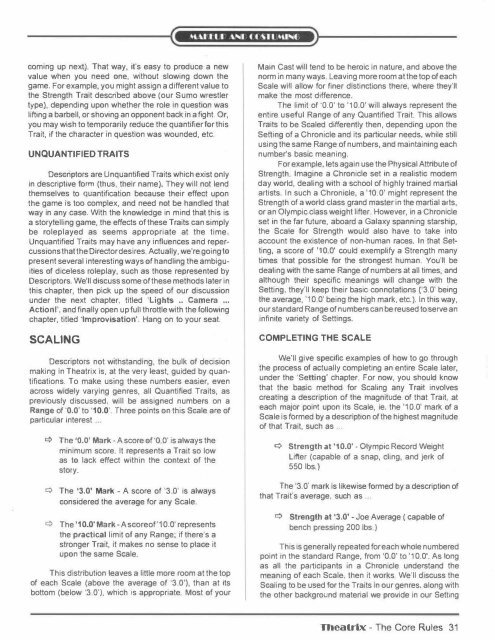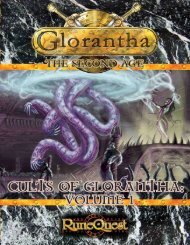Untitled - Index of - Free
Untitled - Index of - Free
Untitled - Index of - Free
You also want an ePaper? Increase the reach of your titles
YUMPU automatically turns print PDFs into web optimized ePapers that Google loves.
com1ng up next). That way, it's easy to produce a new<br />
value when you need one, Without slowing down the<br />
game. For example, you might assign a different value to<br />
the Strength Trait described above (our Sumo wrestler<br />
type), depending upon whether the role In question was<br />
lifting a barbell, or shoving an opponent back in a fight. Or,<br />
you may wish to temporarily reduce the quantifier for this<br />
Trait, if the character 1n question was wounded, etc.<br />
UNQUANTIFJED TRAITS<br />
Descnptors are Unquantified Traits which exist only<br />
in descriptive form (thus, their name). They will not lend<br />
themselves to quantification because their effect upon<br />
the game is too complex, and need not be handled that<br />
way in any case. With the knowledge in mind that this is<br />
a storytelling game, the effects <strong>of</strong> these Traits can simply<br />
be roleplayed as seems appropriate at the time.<br />
Unquantified Traits may have any Influences and reper<br />
cussions that the Director des1res Actually. we're going to<br />
present several interesting ways <strong>of</strong> handling the ambigu<br />
Ities <strong>of</strong> d1celess roleplay, such as those represented by<br />
Descriptors. We 'II discuss some <strong>of</strong> these methods later in<br />
this chapter, then pick up the speed <strong>of</strong> our discussion<br />
under the next chapter, titled 'Lights .. Camera ...<br />
Action!', and finally open up full throttle with the following<br />
chapter, titled 'Improvisation' Hang on to your seat.<br />
SCALING<br />
Descriptors not withstanding, the bulk <strong>of</strong> decision<br />
making In Theatrix IS, at the very least, guided by quan<br />
tifications. To make using these numbers easier, even<br />
across widely varying genres, all Quantified Traits, as<br />
previously discussed, will be assigned numbers on a<br />
Range <strong>of</strong> '0.0' to '10.0'. Three points on this Scale are <strong>of</strong><br />
particular interest ..<br />
The '0.0' Mark-A score <strong>of</strong> ·o.o· is always the<br />
mtnimum score. It represents a Trait so low<br />
as to lack effect w1thtn the context <strong>of</strong> the<br />
story.<br />
Q The '3.0' Mark- A score <strong>of</strong> '3.0' is always<br />
considered the average for any Scale.<br />
¢ The '10.0' Mark-A score<strong>of</strong> '10.0' represents<br />
the practical limit <strong>of</strong> any Range; if there's a<br />
stronger Trait, it makes no sense to place it<br />
upon the same Scale.<br />
This d1stribut1on leaves a little more room at the top<br />
<strong>of</strong> each Scale (above the average <strong>of</strong> '3.0'), than at its<br />
bottom (below '3 0'), which is appropriate. Most <strong>of</strong> your<br />
Main Cast will tend to be hero1c in nature, and above the<br />
norm in many ways Leaving more room at the top <strong>of</strong> each<br />
Scale will allow for finer distinctions there, where they'll<br />
make the most difference.<br />
The limit <strong>of</strong> '0.0' to '10 0' will always represent the<br />
entire useful Range <strong>of</strong> any Quantified Trait. This allows<br />
Traits to be Scaled differently then, depending upon the<br />
Setting <strong>of</strong> a Chronicle and its particular needs, while still<br />
using the same Range <strong>of</strong> numbers, and maintaining each<br />
number's basic meaning.<br />
For example,lets again use the Physical Attribute <strong>of</strong><br />
Strength. Imagine a Chronicle set in a realistic modem<br />
day world, dealing with a school <strong>of</strong> highly trained martial<br />
artists. In such a Chronicle, a '10.0' might represent the<br />
Strength <strong>of</strong> a world class grand master in the martial arts,<br />
or an Olympic class weight lifter However, in a Chronicle<br />
set in the far future, aboard a Galaxy spanning starship,<br />
the Scale for Strength would also have to take mto<br />
account the existence <strong>of</strong> non-human races. In that Set<br />
ting, a score <strong>of</strong> '10.0' could exemplify a Strength many<br />
t1mes that poss1ble for the strongest human. You'll be<br />
dealing with the same Range <strong>of</strong> numbers at all times, and<br />
although their specific meantngs will change with the<br />
Setting, they'll keep their basic connotations ('3.0' being<br />
the average, '1 0.0' being the high mark, etc.). In this way,<br />
our standard Range <strong>of</strong> numbers can be reused to serve an<br />
infinite variety <strong>of</strong> Settings.<br />
COMPLETING THE SCALE<br />
We'll give specific examples <strong>of</strong> how to go through<br />
the process <strong>of</strong> actually completing an entire Scale later,<br />
under the 'Setting' chapter For now, you should know<br />
that the basic method for Scaling any Trait involves<br />
creating a description <strong>of</strong> the magnitude <strong>of</strong> that Trait, at<br />
each major point upon its Scale, ie. the '1 0.0' mark <strong>of</strong> a<br />
Scale is formed by a description <strong>of</strong> the highest magnitude<br />
<strong>of</strong> that Trait, such as<br />
Strength at '10.0'- Olympic Record Wetght<br />
Lifter (capable <strong>of</strong> a snap, cling, and Jerk <strong>of</strong><br />
550 lbs.)<br />
The '3.0' mark Is likew1se formed by a description <strong>of</strong><br />
that Trait's average, such as ...<br />
¢ Strength at '3.0'- Joe Average ( capable <strong>of</strong><br />
bench pressing 200 lbs )<br />
This is generally repeated for each whole numbered<br />
point in the standard Range, from '0.0' to '1 0.0'. As long<br />
as all the participants 1n a Chronicle understand the<br />
meaning <strong>of</strong> each Scale, then it works. We'll d1scuss the<br />
Scaling to be used for the Traits In our genres, along With<br />
the other background material we provide in our Setting<br />
Theat.-lx- The Core Rules 31



